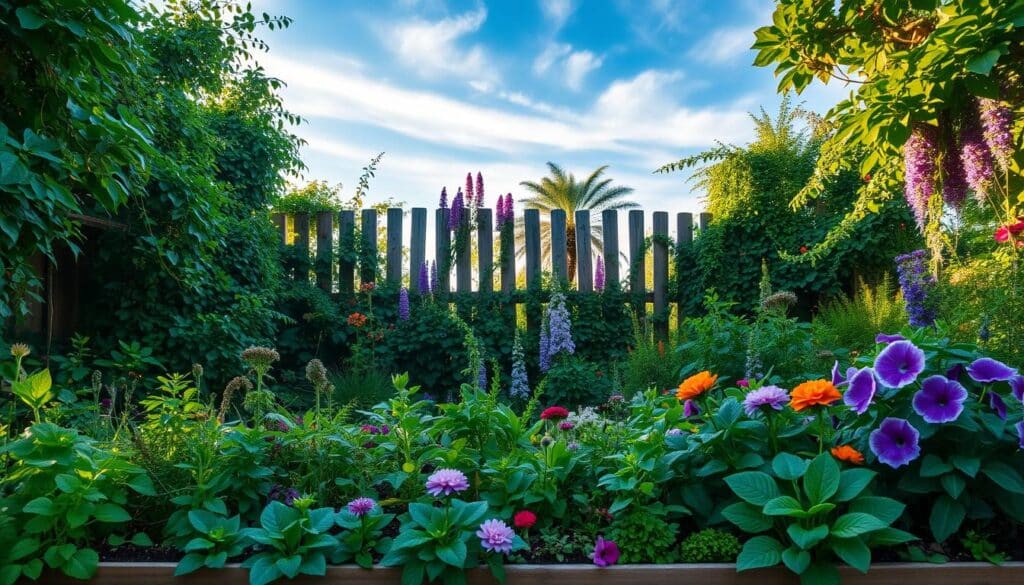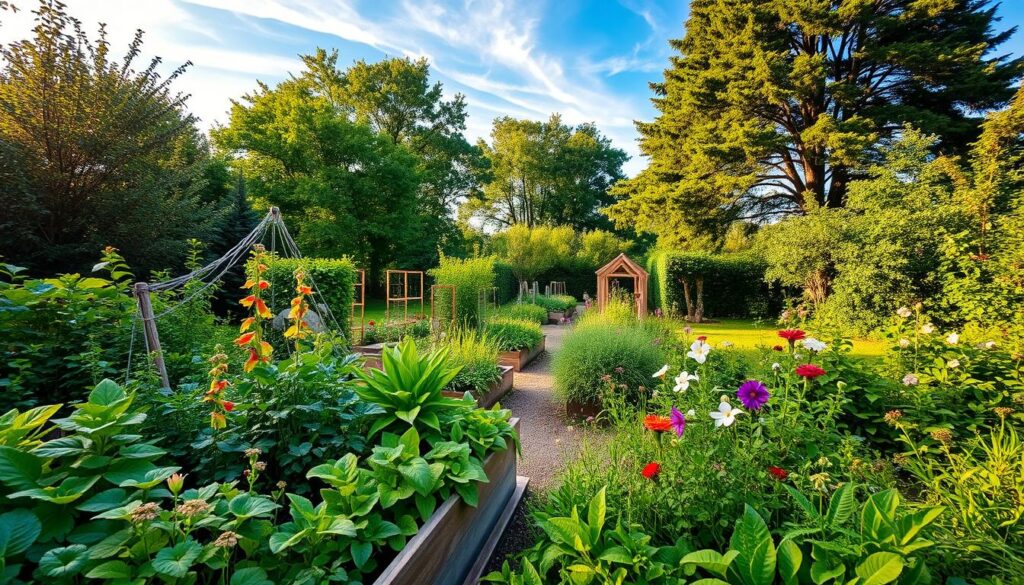Eco-Friendly Gardening with Native Plants Selection

About the Game
The need for environmental care is more obvious today than ever. Eco-friendly gardening uses native plants to make gardens sustainable. These plants help increase biodiversity and reduce resource use, making ecosystems healthier. Native plants adapt well to local conditions, making them great for eco-conscious gardeners. This article will explore the importance of native plants. It will also discuss their benefits for gardens and the environment.

Seek App
Introduction to Eco-Friendly Gardening
Eco-friendly gardening is becoming more popular among homeowners. People now realize how their gardens affect the environment. They are swapping boring lawns for lively native gardens that help the ecosystem.
This trend shows people care about living things and saving resources. Using native plants makes gardens look great and supports the environment. Gardening today is more about helping our planet stay healthy.
Anúncios

Benefits of Native Plants in Gardening
Gardening with native plants is great for the environment and gardeners. They grow well locally, helping ecosystems and increasing biodiversity. Native plants give homes and food to local wildlife. They also need less care than other plants.
Anúncios
Supporting Local Ecosystems
Native plants are key in keeping ecosystems healthy. They offer shelter and food to local animals, boosting biodiversity. This makes homes for pollinators, birds, and helpful bugs. Native plants also improve soil and water quality, important for ecosystems to flourish.
Reducing Maintenance Needs
Native plants adjust easily to local weather. They make gardening easier for those with busy lives. These plants usually resist drought and pests. So, they need fewer fertilizers and pesticides. This way of gardening saves resources and is better for the planet.
Understanding What Native Plants Are
Native plants are those species that grow naturally in a specific area without human help. They fit perfectly into their environments, thanks to special adaptations. These adaptations help them survive in the local weather and soil. They are also known as indigenous plants, which means they’ve been in their regions for a very long time.
Native plants are crucial for the health of local ecosystems. They live in harmony with other organisms, like pollinators and animals that eat plants. Their deep roots help keep the soil in place and recycle nutrients. This makes the ecosystem healthier overall.
Why Choose Native Plants for Your Garden
Choosing native plants for your garden offers many benefits. It supports ecological gardening and sustainability. These plants adjust well to local conditions, saving water and reducing chemicals.
Water Conservation
Native plants need less water, helping in water conservation efforts. Gardeners save time and resources since these plants use local rainfall well. This makes them perfect for areas with less water.
Reduction of Chemical Use
Native plants fight off pests and diseases naturally, cutting down on chemicals. This approach is healthier for the environment, supporting biodiversity and wildlife. It’s a step towards more eco-friendly gardening.
Features of a Sustainable Garden: Native Plants Selection
Choosing native plants is vital for a sustainable garden. These plants do more than just look beautiful; they help the environment too. Gardeners can make spaces that support local animals and plants, boosting ecosystem health.
Enhancing Biodiversity
Native plants are crucial for increasing biodiversity. They give homes and food to many creatures, like bees and butterflies. By adding them to gardens, a balanced natural space is created where wildlife can flourish. This method encourages a healthy setting for:
- Local insects and animals
- Varied plant species
- Natural pest control
Climate Change Mitigation
Native plants are also key in fighting climate change. They absorb CO2 from the air, helping to reduce global warming. Including these plants in gardens aids in overall sustainability goals. The advantages include:
- Less greenhouse gas emissions
- Healthier soil
- Better air quality
How to Select Native Plants for Your Region
Choosing native plants carefully helps keep your garden eco-friendly. Start by figuring out which plants are native to your area. Knowing your local climate and soil types is key. This will help you create a garden that is pretty and good for the environment.
Identifying Local Native Species
Start by identifying local plants that fit your area’s environment. You can get information from native plant groups or local gardens. Here are some tips:
- Look for field guides about your area’s plants.
- Join community workshops on gardening in your region.
- Use online databases about native plants.
Avoiding Invasive Plants
Avoiding invasive plants is very important. These plants can harm local ecosystems by competing with native species. Here are some tips to keep invasives out of your garden:
- Make sure plants are truly native to your area.
- Know your local rules on invasive species.
- Learn about common invasive plants in your region.
Practical Tips for Creating a Native Plant Garden
To start a native plant garden, think about working with nature, not against it. Use plans that help the local wildlife and look amazing. Here’s what you need to keep in mind for your garden.
Designing an Eco-Friendly Layout
Creating a garden that loves nature means thinking about your design. Here are some important ideas:
- Pick a design that lets water flow naturally. This means you’ll use less water.
- Make walkways from eco-friendly materials. This helps the earth breathe better.
- Place plants where they’d naturally grow best. Think about the sun, shade, and moisture they need.
- Have different kinds of plants. Use various heights and colors to draw in bees and butterflies.
Grouping Plants for Optimal Growth
How you arrange your plants is key. Putting those with similar needs together makes your garden easier to care for and plants happier. Follow these steps:
- Put sun-loving plants in bright spots and shade-lovers together in cool spots.
- Group by water needs. This way, you won’t overwater some while drying out others.
- Mix flowers and herbs that keep pests away. This natural trick keeps plants healthy.
- Think about when plants flower. You’ll have blooms all year round.
Native Plants and Wildlife: A Symbiotic Relationship
Native plants and wildlife together form vital bonds that are essential for a balanced ecosystem. These plants are well-suited to their local climates. They offer many benefits to wildlife, helping increase biodiversity and promote healthy living spaces.
Attracting Pollinators and Beneficial Insects
Native plants play a key role in attracting pollinators. They draw bees, butterflies, and hummingbirds. These creatures depend on certain plants for food and to reproduce. By growing native plants, gardeners help these crucial insects survive. Their efforts keep pollinator numbers healthy.
Pollinators are vital for plants to reproduce. This creates a cycle where ecosystems can sustain themselves.
Providing Habitats for Local Wildlife
Using native plants in gardens helps create homes for local wildlife. Birds, small mammals, and helpful insects find food and shelter in these natural settings. This approach helps keep ecosystems balanced. It lets different species live together in peace.
The use of native plants strengthens these relationships. It shows how sustainable gardening can benefit the environment.
Water-Saving Techniques for Native Gardens
It’s key to use water-saving ways to keep native gardens healthy. Smart watering methods help use less water but keep plants healthy. Here are some tips:
- Drip Irrigation: This method delivers water straight to the roots, cutting down on evaporation and runoff.
- Mulching: A layer of organic mulch keeps soil moist, stops weeds, and keeps soil temperature steady.
- Rainwater Harvesting: Using collected rainwater for watering is a green choice.
- Soil Moisture Sensors: These gadgets check how wet the soil is, telling you when to water.
- Xeriscaping: Picking plants that need less water makes a big difference in saving water.
By using these water-saving tips, you can grow beautiful native gardens and help the environment. These steps make your garden look good and manage resources wisely.
Maintaining Soil Health in a Native Plant Garden
Keeping the soil healthy is key to a successful native plant garden. Using organic methods helps the soil and stimulates a lively ecosystem. Good soil offers the nutrients plants need to grow, crucial for gardening that lasts.
Organic Practices for Soil Enrichment
Organic methods improve soil quality safely, avoiding harsh chemicals. Some top strategies are:
- Utilizing cover crops to prevent soil erosion and boost organic matter.
- Incorporating mulch to retain moisture and regulate soil temperature.
- Employing crop rotation to promote diverse nutrient profiles.
These approaches lead to fertile, healthy soil, perfect for native plants.
Composting and Its Benefits
Composting is a key practice, with many benefits. It uses garden and kitchen waste to improve soil. Composting betters soil structure, retains moisture, and makes nutrients more available to plants. It helps keep soil healthy, encouraging a lush native plant garden.
Adopting composting creates a beneficial cycle. This boosts the ecosystem and keeps your garden productive.
Creating a Wildlife-Friendly Environment
Setting up a garden that welcomes wildlife brings many perks, mainly in making ecosystems that last. One way to do this is by using native plants as ground covers. They help control weeds. These plants cut down the need for chemicals and offer homes for local animals. Choosing native plants boosts the garden’s variety of life and its ecological value.
Using Native Ground Covers for Weed Control
Native ground covers stop weeds from taking over. They grow thick and compete for resources, which keeps unwanted plants away. The main benefits are:
- Less time and effort needed than with traditional lawns.
- Better soil health from the addition of organic material.
- A good environment for helpful bugs and local animals.
The Importance of Carbon Sinks
Native plants do more than control weeds; they also help the planet by absorbing carbon dioxide. This process stores carbon, which makes for a healthier environment. By adding native plants to gardens, we see:
- Better air quality because there’s more oxygen.
- Less impact from climate change due to stored carbon.
- A welcoming place for many species, which keeps nature in balance.
Common Mistakes to Avoid in Native Plant Gardening
Gardening with native plants is great but can lead to errors. Knowing common pitfalls improves your gardening journey. Initially, choose plants that fit your area and garden’s unique needs. Picking unsuitable natives might cause them to grow poorly or not at all.
Getting water and sunlight right is vital for your plants. Native plants have their own requirements, different from regular garden species. Too much water or too little light limits what they can achieve. Keeping an eye on these factors helps your garden stay healthy.
Some think native gardens need no upkeep. Yet, doing things like weeding and pest checks is crucial for their health. Following these gardening tips saves time and makes your plants thrive.
Avoiding these mistakes helps you build a lively, eco-friendly garden. It’s important to know what your plants need. This way, your garden will flourish, rewarding your efforts.
Conclusion
As we end our look at eco-friendly gardening, we see how amazing native plants are. They make our gardens look great and help the environment. Gardeners who use native plants help increase biodiversity and support wildlife.
Choosing this way of gardening helps save water and cuts down on chemicals. Using native plants lets our gardens grow well naturally. This is good for both people and animals. It shows a real commitment to keeping our planet healthy.
Starting to use native plants is a strong step toward working with nature to bring back balance. It’s up to us to make gardens that respect our local surroundings. This will help them stay beautiful for many years ahead.
FAQ
What are the main benefits of using native plants in gardening?
How do I choose native plants for my garden?
Are native plants really low maintenance?
Why is water conservation important in gardening?
What are some effective techniques for conserving water in native gardens?
How can I create a wildlife-friendly environment in my garden?
What are common mistakes to avoid when working with native plants?
How do I maintain soil health in my native plant garden?
Can native plants help combat climate change?
Game Details
No
No